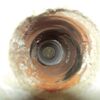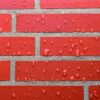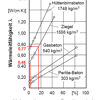Interior insulation should not be installed without expert planning because the hygrothermic behaviour of the existing building is significantly changed by the inside insulation. Serious manufacturers of interior insulation systems provide the relevant indicators and material functions for the advance planning and/or simulation work.

Structural analysis
A structural analysis should always be carried out prior to installing inside insulation.
The first step includes the analysis and assessment of obvious damage and the determination of ‘usual’ indicators with respect to the
- structure and dimensioning of the wall constructions,
- moisture and salt load and their
- causes, like rising damp or façades that are not driving rain-proof.
This also includes the heat-related condition variables of the building
- R-value of the existing wall construction or constructions and
- Heat bridges
Special attention should be paid to the available building materials, in particular the inside of the external walls, with regard to their resistance to moisture and the general construction-related condition of the external construction components.
Fire protection
Construction-related requirements for buildings increase with their dimensions and height. Accordingly, so-called building classes are formed that are usually determined based on the height of the floor of the upper storey. There are more precise definitions in the state construction ordinances, although these may vary slightly from state to state.
Legal building requirements and fire protection properties that are relevant for the planning permission are stated in the building codes and the lists of technical construction regulations of the separate federal states and the Construction Product Lists.
Moisture protection
Due to the interior insulation, only small quantities of thermal energy enters the wall construction. This means that there is hardly any evaporation energy available. As a result, it will be difficult for any penetrated moisture resulting from driving rain or even condensation to dry to the outside during the winter season. The façades remain moist for longer, become more saturated and cool down more quickly. This significantly increases the risk of frost in the masonry and ensuing damage. Against this background, there are several requirements with regard to the moisture penetration in masonry insulated on the inside that should be taken into account when drafting the energetic restoration concept.
Par. 4.2.1 of the DIN 4108-3 lists requirements that state that the dew formed on the inside of parts is uncritical. Compliance with these conditions must be verified in calculations before the installation of inside insulation within the meaning of a minimum requirement.
- One basic prerequisite is that the dew quantity incurred during the dew period mW,T may not be greater than the evaporation quantity mW,V, mWT < mW,V because otherwise the total moisture content of the construction would accumulate over the years.
- In the case of roof and wall constructions, the dew quantity per m² wall surface always remains below 1.0 kg, mWT < 1.0 kg/m², it must remain below 0.5 kg per m², mWT < 0.5 kg/m² on contact surfaces of capillary layers that cannot absorb water, e.g. fibre insulation materials, cavity walls, vapour proof barriers or concrete layers or materials with a water absorption value of < 0.5 kg (m²h^0.5).
- Building materials that come into contact with dew may not be damaged. (e.g. by corrosion)
- Mass-related increases of the moisture level in wood by more than 5% and in wood construction materials by more than 3% are not permitted.
The ‘classic’ Glaser procedure may only be used to verify he named conditions for vapour barrier or vapour-inhibiting systems that are used for external wall constructions where all other moisture penetration is ruled out because here only heat dissipation and vapour diffusion under stationary underlying conditions can be considered. Otherwise, computer programs required to verify the moisture protection of inside insulation systems must be used for hygrothermal simulation. The DIN EN 15026, the WTA information sheet 6-1 and 6-5 offer support.

For the above-mentioned reasons, potential exposure to driving rain needs to be included in the planning deliberations for buildings with inside insulation. Only hygrothermal simulations may be used for verification (see DIN EN 15026 and WTA information sheet 6-1). In come circumstances, the installation of the driving rain protection should be seen as a part of the interior insulation system. Frequently, these buildings have façades with complex designs, clear structures and/or exposed masonry. This often or at least partial rules out the use of water repelling rendering and coats. In the further deliberations, the possibility of constructive moisture protection need to be reviewed first. If possible and feasible in terms of effort and appearance, problem areas such as e.g. cornices, wall crowns, water hammers etc. should be covered. Then the possibility of hydrophobizing impregnation needs to be reviewed. In many cases it is necessary to determine the water absorption of the façade building materials on site using a ‘Karstensche’ test tube or on material samples in the laboratory. In addition to the material types and density, this is an important indicator to select the corresponding materials from extensive databases of the commercially available simulation programs. This procedure is usually enough in most cases because it is rare for the thermal and hygric material functions required for the simulation to be determined specifically for materials used in the building. For more information about this, please see the WTA information sheets 6-1 and 6-2.

The following illustration by the Frauenhofer Institute for Construction Physics shows the decreasing moisture load / successive drying of a brick wall after hydrophobizing for a period of 5 years. Red marks the water level of approx. 16% at the time of hydrophobizing.
This illustration by the Frauenhofer Institute for Construction Physics shows the causal relationship between the moisture level of building materials and the connected thermal conductivity. Using the example of a brick with a water-repellent coating that changes the thermal conductivity over a period of 5 years as shown in figure 1, we see an improvement of the thermal conductivity of 0.77 W/(mK) to 0.46 W/(mK) associated with the successive drying of the brick as a result of the hydrophobizing.


Heat insulation
Hygienic minimum thermal protection
The named part of the DIN 4108-2 describes minimum requirements (see Par. 3.1.2) for thermal protection of external building walls. Compliance of these requirements means that it is highly likely that physically-related moisture damage and health risks through mould infestation can be ruled out if the building is used ‘normally’.
Thermal protection certification acc. to EnEV
If existing buildings are modified, two different verifications methods are possible depending on the scope of the measure.
- Either the currently specified heat transition coefficients (U-values) in accordance with the part procedure need to be observed or
- The maximum values of the annual primary energy requirement of the entire building according to the balancing procedure need to be verified.
The dimensions of the corresponding requirements are stated in the currently valid version of the German energy conservation act.
